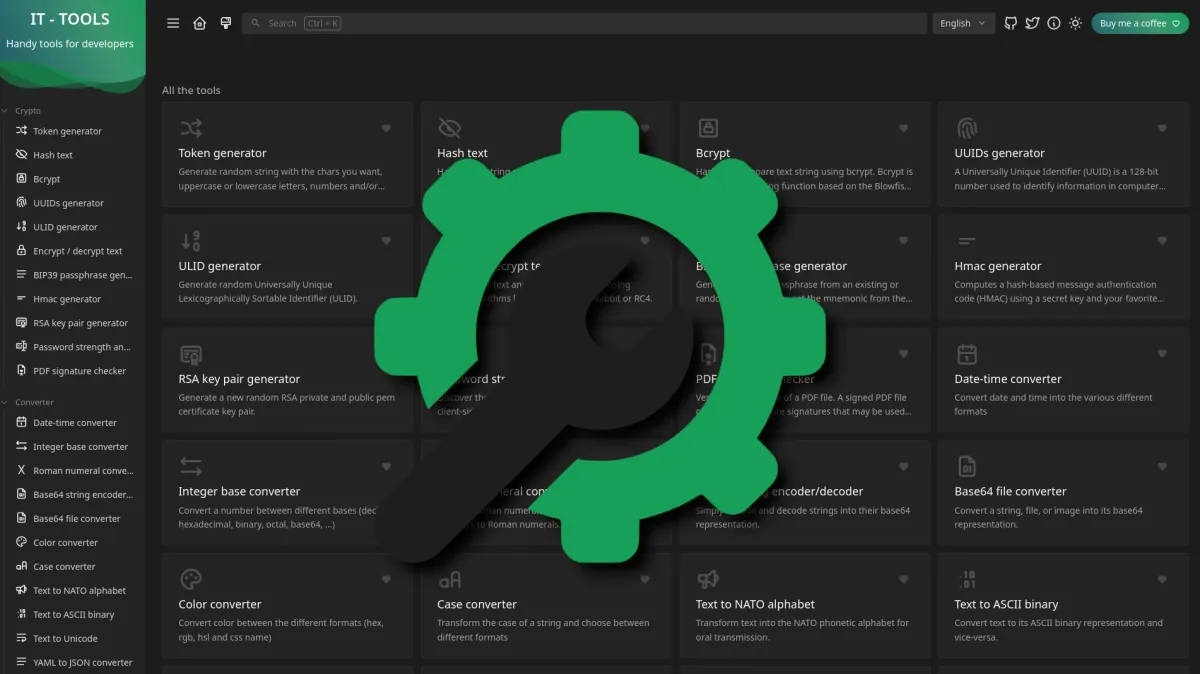IT-Tools: an essential web toolkit for IT pros
1.IntroductionIT-Tools is a very practical toolbox for all “techies” and IT professionals: a single web interface groups dozens and dozens of ready-to-use tools. The icing on the cake: it is an open source project that can be self-hosted on a workstation, a server or a NAS. We will start with a presentation of this toolkit…
1.Introduction
IT-Tools is a very practical toolbox for all “techies” and IT professionals: a single web interface groups dozens and dozens of ready-to-use tools. The icing on the cake: it is an open source project that can be self-hosted on a workstation, a server or a NAS.
We will start with a presentation of this toolkit before talking about its quick installation with Docker. In the same spirit as IT-Tools, we can cite another toolbox mentioned in a previous article: CyberChef.
2.What is IT-Tools?
IT-Tools is an open source project created by Corentin Thomasset, a Frenchman (from Lyon), and which contains many tools organized in several categories. The project is available on GitHub https://github.com/CorentinTh/it-tools and there is also an online version accessible at it-tools.tech.
- Tools for the network
- Calculate an IP subnet.
- Convert an IP address (in binary, for example).
- Get information about a MAC address.
- Generate a new MAC address.
- Generate your own local IP addresses in IPV6, non-routable, for your network (RFC4193 compliant).
- Etc…

- Convert data from one format to another
- Convert the date and time, for example, a timestamp to ISO 8601 format or UTC format.
- Convert a color code to hexadecimal format, RGB format, etc… from a selector.
- Transform the case of a string of characters to different formats.
- Convert Markdown text to HTML and allow printing (in PDF).
- Convert YAML code to JSON format.
- Etc…

- Perform cryptographic operations
- Generate a token
- Get the hash of a text (MD5, SHA1, SHA256, SHA512, etc.).
- Hash and compare a text string using bcrypt.
- Generate UUIDs or ulids.
- Encrypt a clear text and decrypt a ciphertext using cryptographic algorithms such as AES, TripleDES, Rabbit or RC4.
- Generate a new private and public RSA key pair.
- Analyze the strength of a password.
- Verify the signature of a PDF document
- Etc…

- Perform web-related actions
- Encode a text in URL format.
- Parse a URL (parsing).
- Get information about the local machine (resolution, browser, etc.).
- Analyze and decode your JSON Web token (jwt) and display its contents.
- Detect and analyze user-agent chains.
- Getting information about an HTTP code
- Decode Outlook SafeLink links
- Etc…

- Tools around images and videos
- Generate personalized QR codes.
- Generate QR codes to share a Wi-Fi network.
- Perform a video recording from the browser.
- Etc…

- Tools for developers
- Convert a docker run command to a Docker Compose file (great!)
- Crontab generator
- Minifying JSON code
- Formatting SQL queries
- Evaluate a regular expression
- Etc…

In addition, there are other tools to check the format of an IBAN, obtain statistics on a text (number of words, number of characters, etc.), or even transform a text into ASCII Art.
3.Deploy IT-Tool with Docker
To deploy IT-Tools (an open-source collection of browser-based developer tools) using Docker, follow these steps:
✅ Prerequisites
- Docker installed on your system
- Git installed (optional but recommended)
🚀 Deployment Steps
1. Clone the Repository (Optional)
If you want to build from the source:
bashCopierModifiergit clone https://github.com/CorentinTh/it-tools.git
cd it-tools
2. Use the Prebuilt Docker Image (Recommended)
You can pull and run the official Docker image directly:
bashCopierModifierdocker run -d \
--name it-tools \
-p 8080:80 \
ghcr.io/corentinth/it-tools:latest
This runs IT-Tools on port 8080 (http://localhost:8080).
🔧 Optional: Build Your Own Docker Image
If you want to customize or self-host from source:
bashCopierModifier# Inside the cloned repo
docker build -t my-it-tools .
docker run -d \
--name it-tools \
-p 8080:80 \
my-it-tools
📦 Dockerfile (If building manually)
If needed, here’s a basic Dockerfile:
DockerfileCopierModifierFROM node:18 as builder
WORKDIR /app
COPY . .
RUN npm install && npm run build
FROM nginx:alpine
COPY --from=builder /app/dist /usr/share/nginx/html
EXPOSE 80
CMD ["nginx", "-g", "daemon off;"]
🔄 Updating
To update, just pull the latest image:
bashCopierModifierdocker pull ghcr.io/corentinth/it-tools:latest
docker stop it-tools && docker rm it-tools
docker run -d --name it-tools -p 8080:80 ghcr.io/corentinth/it-tools:latest
deploy IT-Tools using Docker Compose
🧾 docker-compose.yml File
Create a file named docker-compose.yml:
yamlCopierModifierversion: '3'
services:
it-tools:
image: ghcr.io/corentinth/it-tools:latest
container_name: it-tools
ports:
- "8080:80"
restart: unless-stopped
▶️ Run It
bashCopierModifierdocker-compose up -d
Then open: http://localhost:8080
🗺️ Deployment Diagram
Here’s a simple diagram of how the deployment works:
vbnetCopierModifier┌────────────────────┐
│ User's Web Browser│
└─────────┬──────────┘
│ HTTP
▼
┌────────────────────┐
│ Host Machine │
│ │
│ ┌────────────────┐│
│ │ Docker Engine ││
│ └──────┬─────────┘│
│ ▼ │
│ ┌────────────────┐│
│ │ IT-Tools Image ││
│ │ (Nginx + App) ││
│ └────────────────┘│
│ Listens on 80 │
└─────────┬───────────┘
│
▼
Exposed to Host
via port 8080:80
✅ Summary
- Access your tools at http://localhost:8080
ghcr.io/corentinth/it-toolsis the official image- Automatically restarts with
restart: unless-stopped
🚀 VPS Deployment of IT-Tools (Docker Compose)
✅ Prerequisites on Your VPS
- Ubuntu 20.04+ (or similar)
- SSH access
- Docker and Docker Compose installed
(If not installed, see step 1 below)
🔧 Step-by-Step Guide
1. Install Docker & Docker Compose
SSH into your VPS:
bashCopierModifierssh root@your-vps-ip
Then run:
bashCopierModifier# Install Docker
curl -fsSL https://get.docker.com -o get-docker.sh
sh get-docker.sh
# Install Docker Compose
sudo curl -L "https://github.com/docker/compose/releases/latest/download/docker-compose-$(uname -s)-$(uname -m)" -o /usr/local/bin/docker-compose
sudo chmod +x /usr/local/bin/docker-compose
2. Create Project Folder
bashCopierModifiermkdir -p /opt/it-tools
cd /opt/it-tools
3. Create docker-compose.yml
bashCopierModifiernano docker-compose.yml
Paste this:
yamlCopierModifierversion: '3'
services:
it-tools:
image: ghcr.io/corentinth/it-tools:latest
container_name: it-tools
ports:
- "80:80"
restart: unless-stopped
Save and exit (Ctrl+O, Enter, Ctrl+X)
4. Launch IT-Tools
bashCopierModifierdocker-compose up -d
Now visit http://your-vps-ip in your browser.
🌐 Optional: Add a Domain + HTTPS (Using Nginx & Certbot)
If you have a domain (e.g. tools.example.com), you can:
- Set your domain A record to your VPS IP
- Install Nginx as a reverse proxy
- Use Let’s Encrypt for SSL
Let me know if you’d like me to guide you through that setup too.

